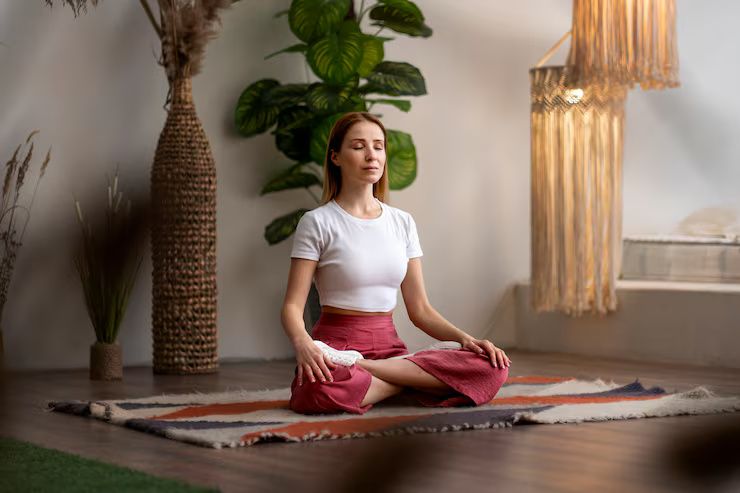Yoga is an ancient mind–body practice rooted in Indian philosophy. It blends physical postures (asanas), breathing techniques (pranayama), and meditation or mindfulness. Over centuries it evolved—from Sanskrit texts like the Yoga Sutras—into a widely practiced wellness activity around the world
In modern life, many face sedentary lifestyles, stress, anxiety, and chronic health concerns. Yoga offers a non-pharmacological way to:

-
Support physical health: By improving flexibility, strength, posture, and balance.
-
Bolster mental health: Through stress reduction, mood enhancement, and improved focus.
-
Complement healthcare: Many people turn to yoga as part of preventive care or to manage chronic conditions like back pain or hypertension.
It’s accessible to diverse populations—from youth to elders—and can be modified for seniors, pregnant people, or individuals recovering from injury. Yoga thus plays a role in preventive health, rehabilitation, and mental wellness across all age groups.
Recent Developments in Yoga (Past Year)
Here are notable trends and findings from the last year or so:
| Date / Time | Trend / Finding |
|---|---|
| Late 2024 | Continued growth of online yoga platforms and livestream classes, making yoga more accessible globally. |
| Early 2025 | Research links regular yoga practice to improved sleep quality and reduced symptoms of anxiety in working-age adults. |
| Mid-2025 | Integration of yoga into workplace wellness programs and public health initiatives in some regions, funded or subsidized by employers or local governments. |
These developments reflect a surge in digital yoga offerings, growing interest in evidence-based health benefits, and institutional recognition of yoga as part of health promotion.
Relevant Laws, Regulations, and Programs
Yoga in India and abroad intersects with policies and programs aimed at promoting wellness:
-
India: The Ministry of AYUSH (Ayurveda, Yoga & Naturopathy, Unani, Siddha, and Homeopathy) actively supports yoga through national campaigns such as International Day of Yoga (celebrated on June 21). State governments sometimes offer free classes in parks or community centers, especially during health awareness weeks.
-
United States: While yoga itself isn't regulated, some states allow wellness practitioners (including yoga therapists) to be reimbursed under health insurance or employer wellness benefits. OSHA and workplace health programs may promote yoga as part of ergonomic or stress-reduction schemes. Professional yoga therapy associations also establish training standards and credentialing.
-
Europe (e.g., UK, EU): Some countries include yoga within publicly funded community health initiatives. For instance, local authorities may offer subsidized classes for older adults, or yoga may be part of mental health counseling referrals. However, there’s no uniform regulation—standards typically arise from professional certifications rather than law.
Tools and Resources for Yoga Practice
Below are several useful tools, platforms, and resources to support your yoga journey:
Online Platforms & Apps:
-
Yoga with Adriene, Down Dog, Glo/Yoga Anytime – apps and websites offering on-demand classes for different levels and needs (focus, mobility, bedtime, etc.)
-
DoYogaWithMe, Gaia – online libraries with classes and guided programs.
Tracking & Training Tools:
-
Mobile apps: Asana Rebel, Pocket Yoga – schedule reminders, track routines, and progress.
-
Yoga journal templates (printable PDFs) – to log type of practice, duration, and physical or emotional notes.
Mindfulness & Breathwork Aids:
-
Apps like Insight Timer, Headspace, or Calm that complement yoga with guided meditations and breathing sessions.
Community & Support:
-
Local yoga studios and community centers—many offer donation-based or sliding-fee classes.
-
Online forums and groups on social platforms (e.g. Reddit’s r/yoga, Facebook yoga groups) where practitioners share tips and experiences.
Educational Resources:
-
Websites: Yoga Alliance, Yoga Journal, National Center for Complementary and Integrative Health (NCCIH)—offer articles, research summaries, and safety guidelines.
-
Books: e.g., Light on Yoga by B.K.S. Iyengar, The Heart of Yoga by T.K.V. Desikachar—widely respected and used in instructor training.
Tools for Physical Practice:
-
Yoga mats, blocks, straps, bolsters—available at many sports-gear retailers, with instructional guidance on proper use to ensure safety and alignment.
Frequently Asked Questions (FAQs)
Q1: Is yoga safe for beginners or people with injuries?
A: Generally, yes—especially when using beginner-friendly classes and modifications. Certified instructors often offer alternate poses for injury recovery. However, individuals with serious conditions should consult a healthcare provider before beginning, and consider working with a medical yoga therapist.
Q2: How often should one practice yoga to see benefits?
A: Even short sessions (15–30 minutes), practiced 3–4 times per week, can yield physical and mental benefits. Consistency matters more than intensity. For greater flexibility or strength gains, longer or daily routines may be beneficial over time.
Q3: What types of yoga provide the best mental health benefits?
A: Styles emphasizing breath and mindfulness—such as Hatha, Restorative, Yin, or Kundalini—are particularly calming and helpful for stress and anxiety. More physical styles (like Vinyasa or Power Yoga) also aid mental well-being through endorphin release and body awareness.
Q4: Can yoga help with weight loss or specific clinical conditions?
A: Yoga supports healthy habits and may contribute to weight management, especially when paired with a balanced diet and aerobic exercise. Research shows yoga can aid in managing back pain, improving flexibility, and reducing stress-related symptoms. However, it’s not a cure-all. For clinical conditions, yoga is best used as a complementary therapy within a broader treatment plan.
Q5: Do I need special equipment or space to practice?
A: Minimal space is needed—often just enough room to stretch your arms in all directions. Essential gear includes a non-slip yoga mat. Optional props (blocks, straps, bolsters) can enhance comfort and alignment—especially for beginners or therapeutic practice.
Final Thought
Yoga is more than physical exercise—it is a practice that nurtures the body, mind, and emotional balance. In today’s fast-paced world, it offers a sustainable way to manage stress, maintain flexibility, and cultivate mental clarity. While it should not replace medical treatment, yoga can be a valuable complement to healthier lifestyles and wellness routines.

